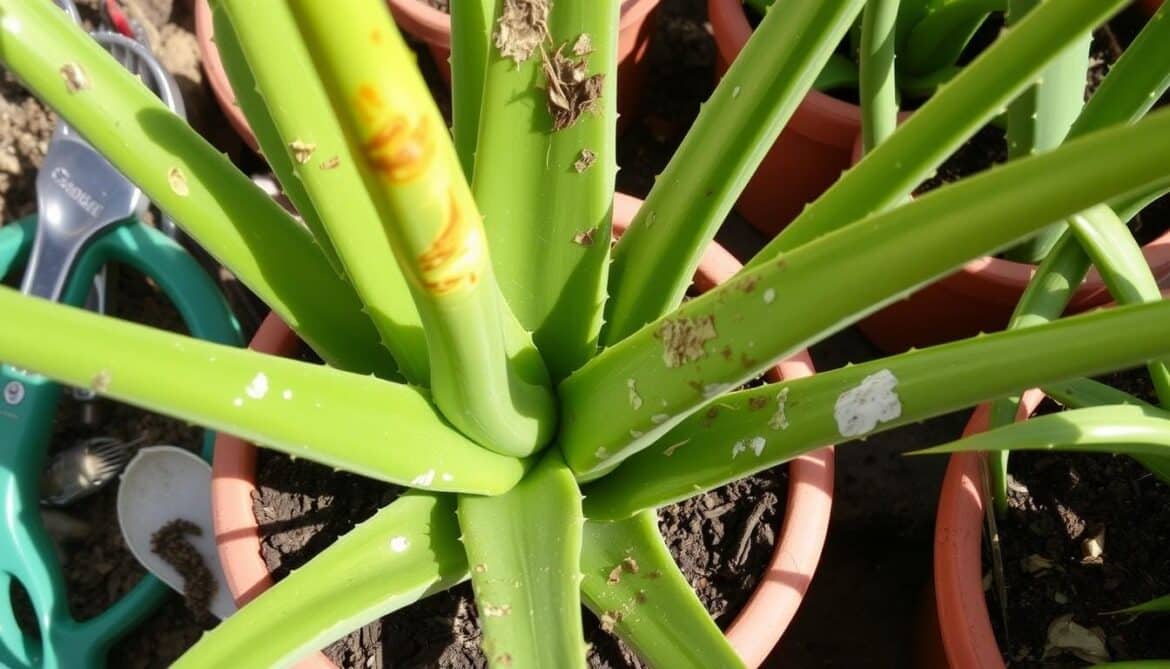I’ve cared for an Aloe vera plant for years, and it brings me joy. These plants are not only beautiful but also good for our health. They can help with digestion and boost our immune system. But, Aloe vera plants can get sick too.
In this guide, we’ll look at common Aloe plant diseases. We’ll talk about their causes, symptoms, and how to prevent them. Knowing how to protect your Aloe plant will keep it healthy and thriving.
Key Takeaways
- Aloe vera plants can face a variety of diseases, including fungal infections, bacterial infections, and pest infestations.
- Proper diagnosis and early intervention are crucial for effectively treating Aloe plant diseases.
- Environmental factors like overwatering, improper lighting, and nutrient deficiencies can contribute to the development of Aloe plant diseases.
- Following best practices in Aloe plant care, such as proper watering, soil selection, and humidity management, can help prevent many common diseases.
- Seeking professional help when necessary can ensure the long-term health and longevity of your Aloe vera plants.
Overview of Aloe Plant Diseases
Aloe plants are known for their healing powers and beauty. But, they can get sick from different diseases. Knowing about these diseases and how to spot them early is key to keeping aloe plants healthy.
What Are Aloe Plant Diseases?
Aloe plants face many problems like fungal, bacterial, and pest issues. Common issues include root rot, leaf spots, and bacterial soft rot. These can cause leaves to turn color, wilt, and grow poorly if not treated.
Importance of Diagnosis
Getting a correct diagnosis is the first step to treating aloe plant diseases. Spotting early signs like color changes, soft leaves, or pests is crucial. Acting fast is essential to keep our aloe plants healthy and alive.
Knowing about aloe plant fungal diseases and aloe plant bacterial diseases helps us protect our plants. By recognizing symptoms early, we can keep our aloe plants thriving. They will continue to offer their beauty and health benefits.
Common Fungal Diseases
Aloe plants can get sick from fungal diseases. Root rot and leaf spots are two big problems. Knowing how to spot and treat these diseases is important for keeping aloe plants healthy.
Root Rot: Causes and Symptoms
Root rot is a big problem for aloe plants. It happens when plants get too much water or have poor drainage. Signs include soft, droopy leaves and a bad smell from the soil.
Leaf Spots: Identification and Management
Leaf spots are another issue for aloe plants. They look like colored spots or patches on the leaves. These spots can stop the plant from making food well.
Treatment Options for Fungal Infections
To fight fungal diseases, start by fixing the environment. Cut down on watering and make sure the soil drains well. Also, make sure the plant has enough air around it. If the problem is bad, you might need to use fungicides. Cutting off sick parts and repotting in new soil can also help.
“Proper diagnosis and prompt treatment are key to successfully managing fungal diseases in aloe plants. By addressing the root causes and implementing the right treatment strategies, we can help our aloe plants thrive and maintain their vibrant, healthy appearance.”
Bacterial Infections in Aloe
Aloe plants can get sick from different bacterial diseases. This can harm their health and look. Bacterial soft rot is a big problem. It makes the plant’s tissues mushy, smells bad, and can kill the leaves.
Recognizing Bacterial Soft Rot
Signs of bacterial soft rot include mushy, waterlogged leaves that fall apart easily. These areas smell bad. This disease often starts from too much water or damage to the plant.
Prevention Strategies for Bacterial Diseases
- Don’t overwater your aloe plants. Make sure the soil can dry out between waterings.
- Keep your aloe well-ventilated to stop bacteria from growing.
- Clean your gardening tools before using them on your aloe. This stops infections from spreading.
- If you see signs of disease, cut off the sick parts and keep the plant away from others.
By watching closely and taking these steps, you can lower the chance of bacterial diseases in your aloe. Regular checks and quick action help keep your succulents healthy and alive.
“Bacterial soft rot is a severe issue that can quickly destroy an aloe plant if left unchecked. Staying alert for the early signs of infection and taking proactive steps is crucial for keeping your aloe healthy and thriving.”
Pest Problems Affecting Aloe Plants
Aloe plants are usually tough, but pests can still harm them. Pests like mealybugs, aloe scale, and mites can damage our aloe plants. It’s important to know about these pests, spot infestations early, and use safe treatments.
Common Pests That Affect Aloes
- Mealybugs: These small, white, cotton-like insects can suck the sap from aloe leaves, leading to discoloration and stunted growth.
- Aloe Scale: Tiny, grey, ridged insects that attach themselves to the leaves, disrupting the plant’s nutrient flow and causing unsightly scarring.
- Aloe Mites: Microscopic pests that burrow into the aloe’s tissues, resulting in gall-like growths and distorted foliage.
Signs of Infestation and Damage
Look for sticky residue, grey or brown ridges, and galls on aloe leaves. These signs mean you need to act fast to save your plant.
Eco-Friendly Pest Control Methods
We choose natural ways to fight pests in aloe plants. Try wiping leaves with a cloth, spraying with water, or using insecticidal soap and isopropyl alcohol. For bad cases, you might need to cut off affected parts and keep the plant separate.
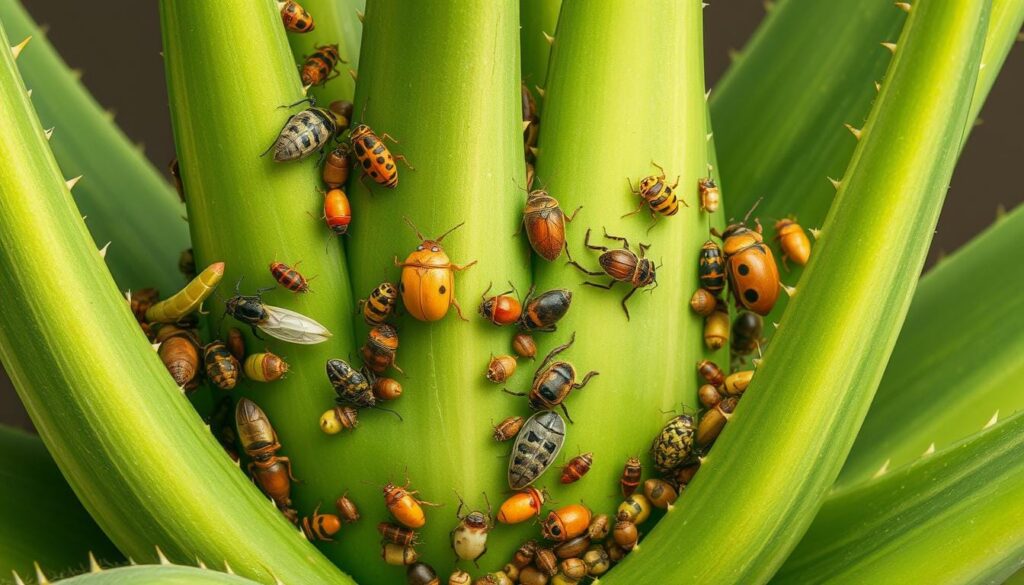
By watching closely and using these safe methods, we can keep our aloe plants healthy. Keeping our garden balanced and acting quickly helps our aloe plants stay beautiful and strong.
Environmental Factors Leading to Disease
When we care for our aloe plants, knowing the environmental factors that cause diseases is key. Overwatering and improper lighting are two major issues. Both can harm the health of our aloe plant care.
Overwatering: Risks and Consequences
Overwatering is a big problem for aloe plants. They do best in well-draining soil and need water only when it’s dry. Too much water can cause root rot, a fungal infection that harms the plant.
Aloe plant symptoms of root rot include yellow leaves, wilting, and mushy roots. To avoid this, water only when the soil feels dry. Make sure the pot drains well.
Light Requirements for Healthy Growth
Light is also crucial for aloe plants. They need bright, indirect sunlight to grow well. Too little light makes them weak and prone to disease.
But, too much direct sunlight can burn their leaves. Finding the right light balance is essential for a healthy aloe plant.
“Aloe plants are remarkably resilient, but they do have specific environmental needs that must be met to ensure their long-term health and vitality.”
By understanding and addressing these environmental factors, we can keep our aloe plants healthy. The right watering and lighting are key to their care.
Cultivation Practices to Prevent Diseases
Keeping our aloe plants healthy is key. By following simple steps, we can make sure they grow well and stay disease-free. This helps them thrive in their environment.
Choosing the Right Soil for Aloes
Aloe plants love well-draining, sandy soil. A mix made for cacti and succulents works great. Or, you can mix regular potting soil with perlite and coarse sand.
Make sure your aloe’s pot has holes for water to drain. This stops water from causing root rot and fungal diseases.
Proper Watering Techniques
Don’t overwater your aloe. Water deeply but not too often. Let the soil dry out before watering again.
How often you water depends on the season, climate, and your aloe’s type. This method prevents bacterial soft rot and root rot.
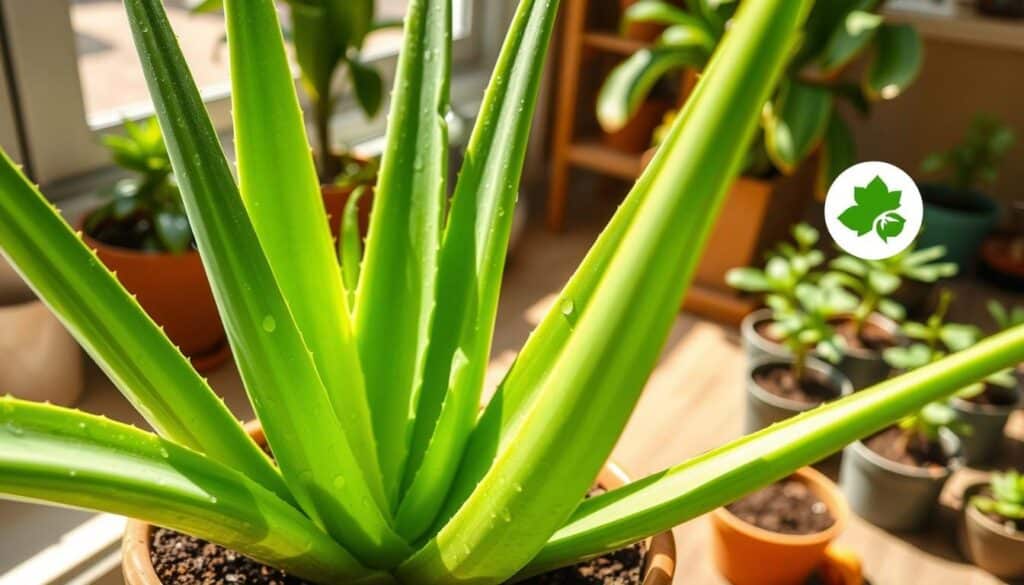
“The key to maintaining a healthy aloe plant is striking a balance between providing adequate water and allowing the soil to dry out between waterings.”
By following these practices, we can keep our aloe plants healthy. Remember, stopping diseases early is the best way to keep our aloe friends happy and healthy.
Nutritional Concerns and Their Impact
Aloe plants are tough and can grow well in poor soil. They don’t need a lot of fertilizer, but some can help them look their best. But, it’s important to not overdo it with the fertilizer. Too little or too much can cause problems.
Nutrient Deficiencies: Identifying Signs
Nutrient problems in aloe plants are not common, but they can happen. Look for yellow leaves, slow growth, or color changes. These signs mean your aloe might not have the right nutrients. Watching your aloe closely can help you catch and fix these issues fast.
Fertilization Best Practices for Aloe Plants
When fertilizing aloe plants, a little goes a long way. Use a weak 10-40-10 houseplant fertilizer and only once a year in spring. Too much fertilizer can harm your aloe’s roots. By following these tips, you can give your aloe the nutrients it needs without harming it.
| Nutrient | Importance for Aloe Plants | Deficiency Symptoms |
|---|---|---|
| Nitrogen (N) | Supports overall plant growth and development | Stunted growth, yellowing leaves |
| Phosphorus (P) | Enhances root development and flowering | Slow growth, purple or reddish leaves |
| Potassium (K) | Improves overall plant vigor and stress resistance | Curling, wilting, or necrotic leaf edges |
“Aloe vera contains more than 75 active ingredients, including enzymes, amino acids, vitamins, and minerals, making it a nutrient-rich plant.”
Seasonal Care Tips for Aloe Plants
As the seasons change, our beloved aloe plants need a little care adjustment. It’s key to keep them healthy and vibrant through the year.
Adjusting Care During Different Seasons
In the summer, aloe plants need more water to stay hydrated. But, be careful not to overwater, as it can cause root rot, a common aloe plant disease. Give them plenty of indirect sunlight and protect them from direct sun to avoid sunburn.
In the fall and winter, aloe plants go dormant. They need less water during this time. Wait until the top inch or two of soil is dry before watering them again.
Winterizing Your Aloe Plants
If you live in zones 10-12, your aloe plants don’t need special care in winter. But, if it gets cold where you live, you must protect them from frost and freezing.
- Bring potted aloe plants indoors or place them in a sheltered spot, like a greenhouse or cold frame.
- For outdoor aloe plants, cover them with a frost cloth or plant blanket to keep them warm.
- Watch your aloe plants for signs of stress, like wilting or discolored leaves, and adjust their care as needed.
By knowing your aloe plants’ seasonal needs and caring for them properly, you can keep them healthy and beautiful. This will enhance the beauty they add to your home or garden.

“Aloe vera is a versatile and resilient plant, but it’s important to adjust its care throughout the seasons to keep it thriving.”
The Role of Humidity in Aloe Health
Caring for aloe plants means paying attention to humidity. Aloe vera loves dry air and does well in indoor humidity levels. Knowing the right humidity and managing it is crucial for our aloe plants’ health.
Optimal Humidity Levels for Aloes
The best humidity for aloe vera is between 40 to 50 percent. This range helps the plant grow well without getting too wet or dry.
How to Manage Indoor Humidity
Keeping humidity right can be tough, especially in dry places or winter. Here are ways to manage humidity for aloe plants:
- Using a humidifier to add moisture to the air
- Employing pebble trays filled with water to create a humid microclimate
- Grouping plants together to increase humidity levels
- Enhancing airflow to prevent stagnant, damp conditions
- Utilizing dehumidifiers, if necessary, to control excessive moisture
Don’t mist aloe plants to avoid fungal problems. Instead, water them right and make sure the soil drains well.
By knowing the right humidity and managing it, we can keep our aloe plants healthy and thriving.
Disease Management and Treatment Options
Keeping our aloe plants healthy is a big job. We need to manage diseases well. We can use both chemical and natural treatments, depending on the problem.
Using Fungicides and Bactericides Safely
Fungicides can fight fungal diseases like root rot and leaf spots. But, we must use them carefully. Always read the label and test on a small area first.
Bactericides are good for bacterial infections, like soft rot. Use them as directed and watch how the plant reacts.
Natural Remedies for Aloe Plant Health
- Cinnamon powder: It fights fungal diseases. Sprinkle it on the soil or affected areas.
- Neem oil: It’s a natural bug killer. It also fights pests that can harm aloe plants.
- Baking soda solution: Mix baking soda with water. It helps prevent and treat fungal infections on leaves.
Using natural remedies is good. But, we must follow the instructions and watch the plant closely. This ensures the treatment works without harming the plant.
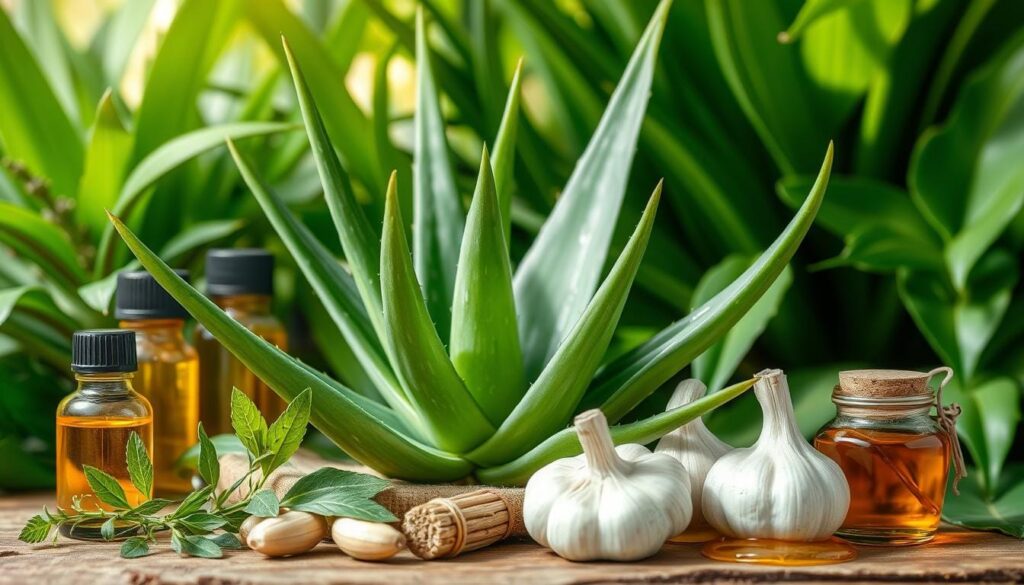
“Proper diagnosis and timely intervention are key to managing aloe plant diseases effectively.”
By trying both chemical and natural treatments, we can find the best way to keep our aloe plants healthy. This way, they stay healthy and strong for a long time.
Importance of Regular Inspection
Keeping our aloe plants healthy means we must watch them closely. Regular checks help us spot diseases, pests, or stress early. This way, we can fix problems quickly and keep our plants safe.
How to Conduct a Thorough Inspection
When checking your aloe plants, look at the leaves, stems, and soil carefully. Watch for any color changes, wilting, or unusual growths. Also, feel the leaves and stems for pests and check the soil moisture.
- Carefully inspect the leaves for spots, discoloration, or signs of pest damage.
- Examine the stems for any soft or mushy areas that could indicate a fungal or bacterial infection.
- Check the soil moisture levels to ensure you are not over or under-watering your aloe plant.
- Inspect the plant’s root system for signs of root rot or other root-related issues.
Keeping a Health Log for Our Aloe Plants
Keeping a health log is also key. It helps you track watering, fertilizing, and treatments. This way, you can spot patterns and solve problems early. It’s also useful when you need advice from experts.
| Date | Observations | Actions Taken |
|---|---|---|
| March 15, 2023 | Leaves starting to show signs of discoloration and spotting | Adjusted watering schedule, applied organic fungicide |
| April 5, 2023 | Leaves appear healthy, no new issues observed | Continued monitoring, no additional actions required |
| May 1, 2023 | Detected mealybugs on the stems | Manually removed pests, applied insecticidal soap |
Regular checks and a detailed health log help us manage aloe plant diseases and problems. This way, we can give our aloe plants the best care and keep them healthy for a long time.
Long-Term Care for Aloe Will Reduce Disease Risk
Keeping your aloe plant healthy is a long-term job, but it’s worth it. By taking good care of it, you can lower disease risks. This way, your aloe will stay healthy for many years.
Best Practices for Longevity
Repotting your aloe every 2-3 years is key. It gives the roots room to grow and prevents soil problems. Use a potting mix made for succulents when you repot.
Pruning dead or damaged leaves helps your aloe grow well. Use sharp scissors to cut off bad leaves without hurting the plant’s center.
As your aloe gets older, it might need less water. Watch the soil and your plant to find the best watering time.
Keeping Track of Plant Health
Checking your aloe often is important. Look for pests, diseases, or stress signs like color changes, wilting, or odd growth.
Keep a log of your aloe’s care and any changes. This helps you spot trends and make better care choices for your aloe.
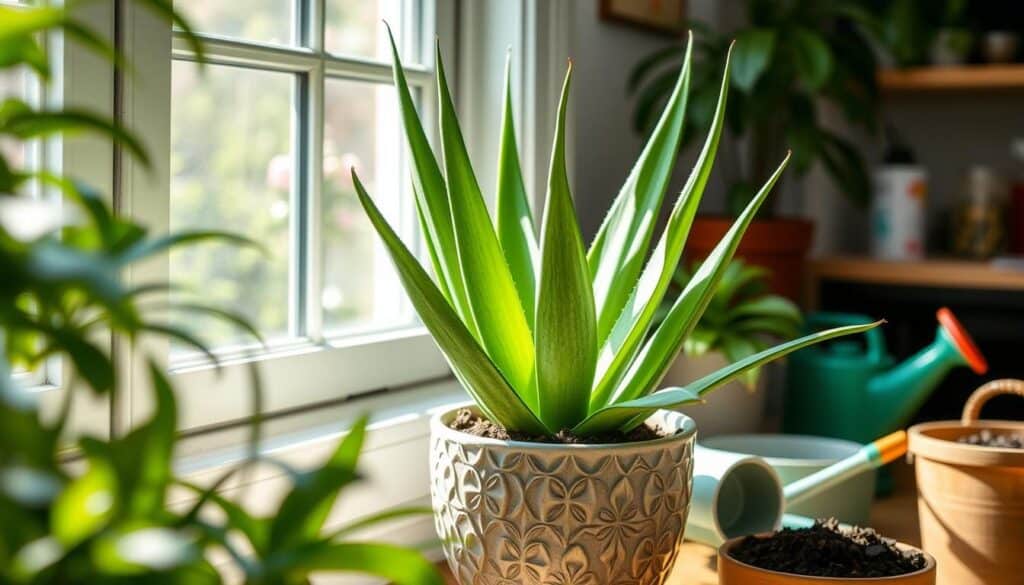
“Careful monitoring of plant health and prompt treatment of any issues will help ensure the well-being of aloe plants.”
By following these care tips, you can enjoy your aloe for many years. Remember, being proactive in caring for your aloe is the best way to keep it healthy and disease-free.
When to Seek Professional Help
We love taking care of our aloe plants. But sometimes, we need help from experts. If you’ve tried everything and still see problems, it’s time to call for help.
Signs That Require Expert Attention
Watch out for signs like fast decline, widespread color changes, or wilting. These could mean your plant needs special care.
Also, if you think your plant has a bacterial or fungal infection, get a plant expert. These diseases are hard to spot and treat without the right help.
Finding a Local Plant Specialist
- First, contact your local botanical garden or university extension office. They have experts who can help with aloe plant treatment, aloe plant care, and aloe plant diseases.
- Look for local nurseries or garden centers with knowledgeable staff. They can give you advice and solutions for your aloe plant.
- Try online plant forums or communities. They might know experts in your area.
Don’t wait to get help if your aloe plant is struggling. The right advice can help your plant recover and stay healthy.
Conclusion: Keeping Our Aloe Plants Healthy
Keeping aloe plants healthy is rewarding and requires a full care approach. Knowing common diseases and how to prevent them lets us enjoy aloe’s benefits. Aloe vera is studied for its healing properties, from skin care to wound healing.
Recap of Key Care Tips
Watering right, giving enough sunlight, and using well-draining soil are key. Regular checks for diseases and pests help prevent problems. Fertilizing correctly and adjusting care with the seasons also helps our aloe plants thrive.
Staying Informed on Aloe Health News
Staying current with aloe care research is crucial. Check out trusted gardening sites and join local horticultural groups. This way, we learn new ways to care for our aloe plants. As we learn more, we can enjoy their beauty and benefits for years.
